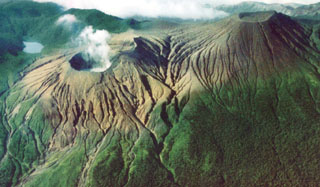Report on Rincon de la Vieja (Costa Rica) — November 1982
Scientific Event Alert Network Bulletin, vol. 7, no. 11 (November 1982)
Managing Editor: Lindsay McClelland.
Rincon de la Vieja (Costa Rica) No activity at the summit crater
Please cite this report as:
Global Volcanism Program, 1982. Report on Rincon de la Vieja (Costa Rica) (McClelland, L., ed.). Scientific Event Alert Network Bulletin, 7:11. Smithsonian Institution. https://doi.org/10.5479/si.GVP.SEAN198211-345020
Rincon de la Vieja
Costa Rica
10.83°N, 85.324°W; summit elev. 1916 m
All times are local (unless otherwise noted)
"In November the odor of H2S was present from the summit crater, but there was no visible gas plume and no eruptive activity. Low-temperature steam vents and mudpots persisted at Estación las Pailas, at the foot of the volcano."
Geological Summary. Rincón de la Vieja, the largest volcano in NW Costa Rica, is a remote volcanic complex in the Guanacaste Range. The volcano consists of an elongated, arcuate NW-SE-trending ridge constructed within the 15-km-wide early Pleistocene Guachipelín caldera, whose rim is exposed on the south side. Sometimes known as the "Colossus of Guanacaste," it has an estimated volume of 130 km3 and contains at least nine major eruptive centers. Activity has migrated to the SE, where the youngest-looking craters are located. The twin cone of Santa María volcano, the highest peak of the complex, is located at the eastern end of a smaller, 5-km-wide caldera and has a 500-m-wide crater. A Plinian eruption producing the 0.25 km3 Río Blanca tephra about 3,500 years ago was the last major magmatic eruption. All subsequent eruptions, including numerous historical eruptions possibly dating back to the 16th century, have been from the prominent active crater containing a 500-m-wide acid lake located ENE of Von Seebach crater.
Information Contacts: R. Stoiber, S. Williams, H.R. Naslund, C. Connor, J. Prosser, and J.B. Gemmell, Dartmouth College; E. Malavassi and J. Barquero H., Univ. Nacional, Heredia.

